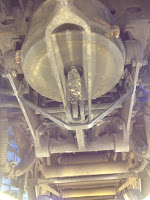General
facts:
- A locomotive and a train aren't the same thing - locomotive refers to the vehicle that provides the power to move carriages and train refers to the locomotive with carriages attached
Channel Tunnel
I live
pretty close to the channel tunnel in Kent, so I might conduct a day trip there
over Christmas to do some research with my little brother (who's obsessed with
trains). I'm pretty sure my brother has a documentary about it somewhere too
which I'll have to rewatch. Some super cool facts I found out about it:
- · Runs for 31.4 miles beneath the English channel
- · Includes the longest section of underwater tunnel in the world
- · Constructed by 13,000 workers over 6 years
- · Recognised as one of the seven wonders of the modern world by the American Society of Civil Engineers
- · Opened in 1994 (2 years before I was born)
- · Carries 48,000 people (!!!) between England and France every day
- · 4.3 million cubic metres of earth and rock was displaced, which was then deposited at Shakespeare cliff near Dover, increasing the size of the UK by 90 acres
'The Tale of
Two Coaches'
Coach No. 2
Narrow Gauge Lynton & Barnstaple railway in north Devon closed in 1935 and coaches were sold off at auction. Railway enthusiast Mr Copleston bought Coach No 2 to use as a summerhouse/smoking room in the garden of the Rectory in Clannaborough, Devon. It was built in 1897 as a 'saloon brake composite' carriage containing first and third class accommodation and a guard's department. The 20 mile journey to move the coach took 3 days and cost more than Mr Copleston paid at auction for the carriage. It was moved to York in 1982.
Narrow Gauge Lynton & Barnstaple railway in north Devon closed in 1935 and coaches were sold off at auction. Railway enthusiast Mr Copleston bought Coach No 2 to use as a summerhouse/smoking room in the garden of the Rectory in Clannaborough, Devon. It was built in 1897 as a 'saloon brake composite' carriage containing first and third class accommodation and a guard's department. The 20 mile journey to move the coach took 3 days and cost more than Mr Copleston paid at auction for the carriage. It was moved to York in 1982.
The Duchess of
Hamilton
- · One of the most powerful steam locomotives to run on Britain's railways
- · One of 38 Princess Coronation class locomotives
- · The fireman had to feed at least 1 ton of coal into its firebox every hour! An average of 6 tons was shifted on an average journey (no wonder we're running out of coal - bloody hell)
- · Withdrawn from service in 1964
- · You could walk under this locomotive - I got some cool machinery pictures of the underside - so intricate!
The Flying
Scotsman
- · Fastest express service between London and Edinburgh
- · From June 1862 the 10.00 express passenger services departed from London Kings Cross and Edinburgh Waverly. This weekday service still runs today
- · Locomotive 4472 was named after the Flying Scotsman service but it is actually one of many locomotives that has pulled the famous express
- · Steam locomotives on the non-stop service consumed 13,000 gallons (59,100 litres) of water - equivalent to 312,000 mugs of tea (the most British comparison ever)
- · In 1948 there were 286 signal boxes controlling trains on this route - in 2002 nine boxes did the same job
·
Japanese
Maglev trains
- · They float! Or 'magnetically levitate'
Mallard
I went in
the cab of the locomotive and talked to the woman in there about how it worked
- she showed me what a fireman would have done and what all the valves and
switches etc did. A fireman would have shovelled coal into the firebox about 8
times an hour. They also had water troughs alongside tracks that you could
scoop up water from as the train went past to refill the tank. Water would
squirt out of the pipe at each level to let you know how full the tank was.
The
Turntable
- · 722 men and boys worked on it
- · Up to 160 trains were moved on it per week
- · I took a video of the guy giving a talk about the turntable and the demonstration of it turning (but Blogger won't let me upload it because it's bigger than 100MB)




















No comments:
Post a Comment